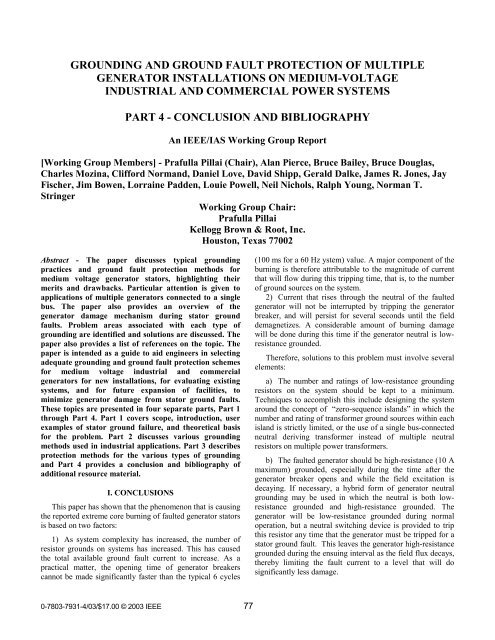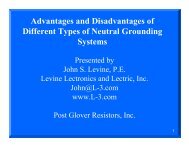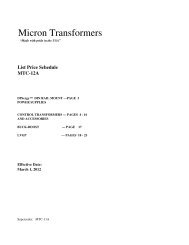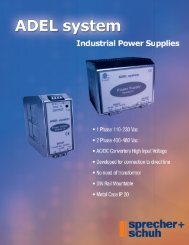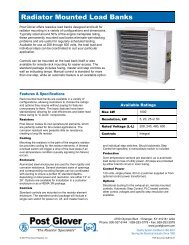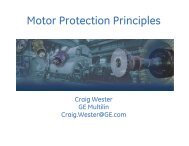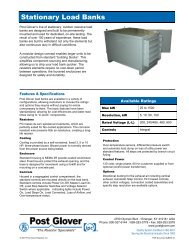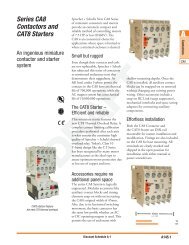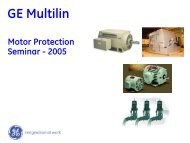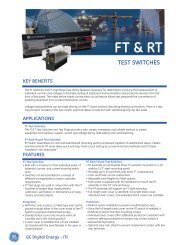IEEE Hybrid Grounding
IEEE Hybrid Grounding
IEEE Hybrid Grounding
Create successful ePaper yourself
Turn your PDF publications into a flip-book with our unique Google optimized e-Paper software.
GROUNDING AND GROUND FAULT PROTECTION OF MULTIPLE<br />
GENERATOR INSTALLATIONS ON MEDIUM-VOLTAGE<br />
INDUSTRIAL AND COMMERCIAL POWER SYSTEMS<br />
PART 4 - CONCLUSION AND BIBLIOGRAPHY<br />
An <strong>IEEE</strong>/IAS Working Group Report<br />
[Working Group Members] - Prafulla Pillai (Chair), Alan Pierce, Bruce Bailey, Bruce Douglas,<br />
Charles Mozina, Clifford Normand, Daniel Love, David Shipp, Gerald Dalke, James R. Jones, Jay<br />
Fischer, Jim Bowen, Lorraine Padden, Louie Powell, Neil Nichols, Ralph Young, Norman T.<br />
Stringer<br />
Working Group Chair:<br />
Prafulla Pillai<br />
Kellogg Brown & Root, Inc.<br />
Houston, Texas 77002<br />
Abstract - The paper discusses typical grounding<br />
practices and ground fault protection methods for<br />
medium voltage generator stators, highlighting their<br />
merits and drawbacks. Particular attention is given to<br />
applications of multiple generators connected to a single<br />
bus. The paper also provides an overview of the<br />
generator damage mechanism during stator ground<br />
faults. Problem areas associated with each type of<br />
grounding are identified and solutions are discussed. The<br />
paper also provides a list of references on the topic. The<br />
paper is intended as a guide to aid engineers in selecting<br />
adequate grounding and ground fault protection schemes<br />
for medium voltage industrial and commercial<br />
generators for new installations, for evaluating existing<br />
systems, and for future expansion of facilities, to<br />
minimize generator damage from stator ground faults.<br />
These topics are presented in four separate parts, Part 1<br />
through Part 4. Part 1 covers scope, introduction, user<br />
examples of stator ground failure, and theoretical basis<br />
for the problem. Part 2 discusses various grounding<br />
methods used in industrial applications. Part 3 describes<br />
protection methods for the various types of grounding<br />
and Part 4 provides a conclusion and bibliography of<br />
additional resource material.<br />
I. CONCLUSIONS<br />
This paper has shown that the phenomenon that is causing<br />
the reported extreme core burning of faulted generator stators<br />
is based on two factors:<br />
1) As system complexity has increased, the number of<br />
resistor grounds on systems has increased. This has caused<br />
the total available ground fault current to increase. As a<br />
practical matter, the opening time of generator breakers<br />
cannot be made significantly faster than the typical 6 cycles<br />
(100 ms for a 60 Hz ystem) value. A major component of the<br />
burning is therefore attributable to the magnitude of current<br />
that will flow during this tripping time, that is, to the number<br />
of ground sources on the system.<br />
2) Current that rises through the neutral of the faulted<br />
generator will not be interrupted by tripping the generator<br />
breaker, and will persist for several seconds until the field<br />
demagnetizes. A considerable amount of burning damage<br />
will be done during this time if the generator neutral is lowresistance<br />
grounded.<br />
Therefore, solutions to this problem must involve several<br />
elements:<br />
a) The number and ratings of low-resistance grounding<br />
resistors on the system should be kept to a minimum.<br />
Techniques to accomplish this include designing the system<br />
around the concept of “zero-sequence islands” in which the<br />
number and rating of transformer ground sources within each<br />
island is strictly limited, or the use of a single bus-connected<br />
neutral deriving transformer instead of multiple neutral<br />
resistors on multiple power transformers.<br />
b) The faulted generator should be high-resistance (10 A<br />
maximum) grounded, especially during the time after the<br />
generator breaker opens and while the field excitation is<br />
decaying. If necessary, a hybrid form of generator neutral<br />
grounding may be used in which the neutral is both lowresistance<br />
grounded and high-resistance grounded. The<br />
generator will be low-resistance grounded during normal<br />
operation, but a neutral switching device is provided to trip<br />
this resistor any time that the generator must be tripped for a<br />
stator ground fault. This leaves the generator high-resistance<br />
grounded during the ensuing interval as the field flux decays,<br />
thereby limiting the fault current to a level that will do<br />
significantly less damage.<br />
0-7803-7931-4/03/$17.00 © 2003 <strong>IEEE</strong> 77


